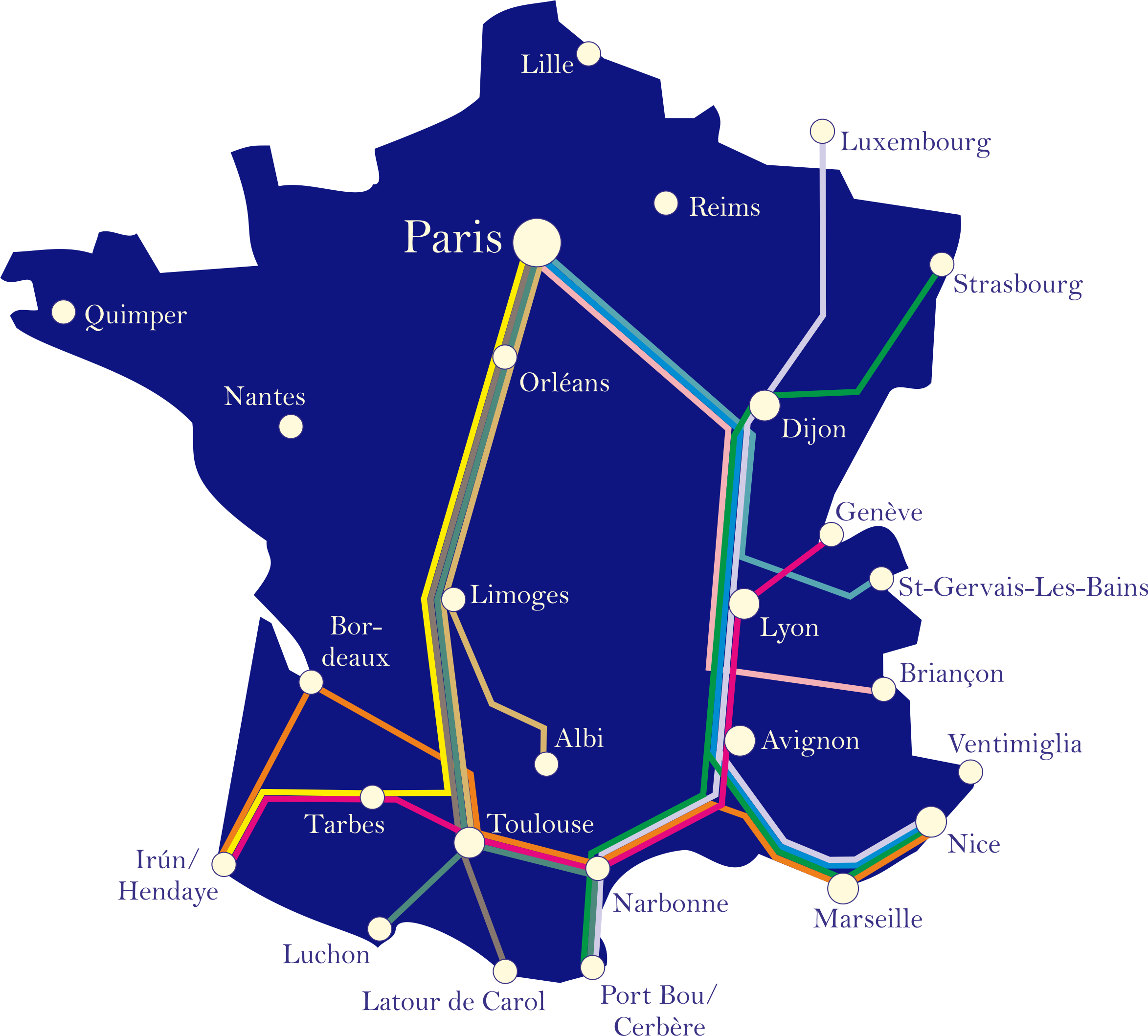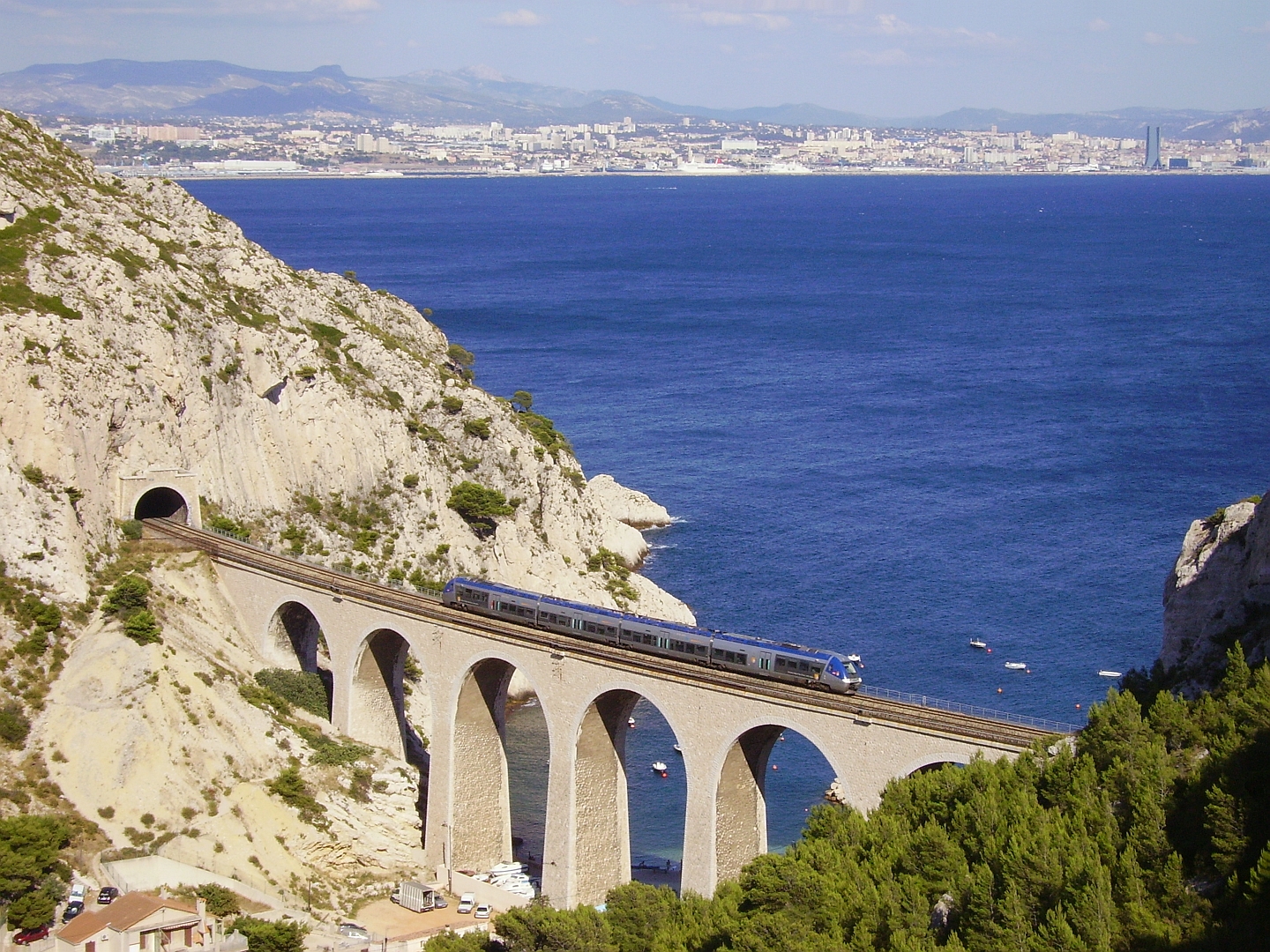|
Rodez Station
The gare de Rodez is a railway station in Rodez, Occitanie, France. The station is on the Capdenac–Rodez, Castelnaudary–Rodez and Sévérac-le-Château–Rodez lines. The station is served by Intercités de nuit (night train) and TER Ter or TER may refer to: Places * River Ter, in Essex, England * Ter (river), in Catalonia * Ter (department), a region in France * Torre (river), (Slovene: ''Ter''), a river in Italy * Ter, Ljubno, a settlement in the Municipality of Ljubno ob ... (local) services operated by SNCF. Train services The following services currently call at Rodez: *night services (''Intercités de nuit'') Paris–Orléans–Figeac–Rodez–Albi *local service (TER Occitanie) Toulouse–Albi–Rodez *local service (TER Occitanie) Brive-la-Gaillarde–Figeac–Rodez Train services between Rodez and Millau were suspended in 2017, and are expected to be resumed in 2026. As a replacement, TER Occitanie bus services to Millau are offered. References Railwa ... [...More Info...] [...Related Items...] OR: [Wikipedia] [Google] [Baidu] |
Rodez
Rodez ( or ; oc, Rodés, ) is a small city and commune in the South of France, about 150 km northeast of Toulouse. It is the prefecture of the department of Aveyron, region of Occitania (formerly Midi-Pyrénées). Rodez is the seat of the communauté d'agglomération Rodez Agglomération, of the First Constituency of Aveyron as well as of the general Council of Aveyron. Former capital of the Rouergue, the city is seat of the Diocese of Rodez and Vabres. Its inhabitants are called ''Ruthénois'', from the name of the Ruteni, a Gallic tribe which once occupied the territory, the former demonym of "Rodanois" (from Occitan ''rodanés'') having given way to this scholarly form. Geography Location Located in the south of France, in the heart of the triangle formed by Toulouse, Clermont-Ferrand and Montpellier, in the western foothills of the Massif Central, the Rodez landscape is situated between the valleys and high plateaus of and the moist hills of Ségala. It exten ... [...More Info...] [...Related Items...] OR: [Wikipedia] [Google] [Baidu] |
Réseau Ferré De France
Réseau ferré de France (RFF, french: French Rail Network) was a French company which owned and maintained the France, French national railway network from 1997 to 2014. The company was formed with the rail assets of SNCF in 1997. Afterwards, the trains were operated by the SNCF, the national railway company, but due to EU Directive 91/440, European Union Directive 91/440, the Government of France was required to separate train operations from the railway infrastructure. On 1 January 2015, RFF became ''SNCF Réseau'', the operational assets of SNCF became ''SNCF Mobilités'', and both groups were placed under the control of SNCF. Unlike other infrastructure managers, RFF did not provide maintenance services or rail traffic control operations, which were both done by SNCF Infra on RFF's behalf. Furthermore, SNCF retained the ownership of stations. In September 2013, RFF had over €32 billion of debt. Overview The RFF was constituted with SNCF's infrastructure assets, and debts ... [...More Info...] [...Related Items...] OR: [Wikipedia] [Google] [Baidu] |
SNCF
The Société nationale des chemins de fer français (; abbreviated as SNCF ; French for "National society of French railroads") is France's national state-owned railway company. Founded in 1938, it operates the country's national rail traffic along with Monaco, including the TGV, on France's high-speed rail network. Its functions include operation of railway services for passengers and freight (through its subsidiaries SNCF Voyageurs and Rail Logistics Europe), as well as maintenance and signalling of rail infrastructure (SNCF Réseau). The railway network consists of about of route, of which are high-speed lines and electrified. About 14,000 trains are operated daily. In 2010 the SNCF was ranked 22nd in France and 214th globally on the Fortune Global 500 list. It is the main business of the SNCF Group, which in 2020 had €30 billion of sales in 120 countries. The SNCF Group employs more than 275,000 employees in France and around the world. Since July 2013, the SNCF Grou ... [...More Info...] [...Related Items...] OR: [Wikipedia] [Google] [Baidu] |
Occitania (administrative Region)
Occitania ( ; french: Occitanie ; oc, Occitània ; ca, Occitània ) is the southernmost administrative region of metropolitan France excluding Corsica, created on 1 January 2016 from the former regions of Languedoc-Roussillon and Midi-Pyrénées. The Council of State approved Occitania as the new name of the region on 28 September 2016, coming into effect on 30 September 2016. The modern administrative region is named after the larger cultural and historical region of Occitania, which corresponds with the southern third of France. The region of Occitania as it is today covers a territory similar to that ruled by the Counts of Toulouse in the 12th and 13th centuries. The banner of arms of the Counts of Toulouse, known colloquially as the Occitan cross, is used by the modern region and is also a popular cultural symbol. In 2015, Occitania had a population of 5,839,867. Toponymy Enacted in 2014, the territorial reform of French regions had been subject to debate for many years. ... [...More Info...] [...Related Items...] OR: [Wikipedia] [Google] [Baidu] |
Intercités De Nuit
Intercités de Nuit is a brand name used by France’s national railway company, SNCF, to denote overnight passenger rail services in France. It was known as ''Corail Lunéa'' before 2009 and as ''Lunéa'' from 2010 to 2012. Between 2013 and 2017, most services were cancelled due to budget cuts. Only four routes, from Paris to Briançon, Albi, Latour de Carol and Nice, were kept.SNCF Intercités, Lignes de nuit retrieved 16 November 2017 The brand has since been reintegrated into the main network. Network in 2022 As of 2022, the Intercités de Nuit network consisted of the following lines:[...More Info...] [...Related Items...] OR: [Wikipedia] [Google] [Baidu] |
Transport Express Régional
Transport express régional (, usually shortened to TER) is the brand name used by the SNCF, the French national railway company, to denote rail service run by the regional councils of France, specifically their organised transport authorities. The network serves French regions; Île-de-France (Transilien) and Corsica ( CFC) have their own specific transport systems. Every day, over 800,000 passengers are carried on 5,700 TER-branded trains.Le TER en 2030 ''SNCF'' Retrieved 2011-02-15 TER is part of , a branch of the SNCF dealing with urban and regional passenger rail, which also includes |
Millau
Millau (; oc, Milhau ) is a Communes of France, commune in the Aveyron Departments of France, department in the Occitania (administrative region), Occitanie Regions of France, region in Southern France. One of two Subprefectures in France, subprefectures in Aveyron alongside Villefranche-de-Rouergue, it is located to the southeast of the Prefectures in France, prefecture, Rodez. With a population of 22,002 as of 2018, it is situated at the confluence of the rivers Tarn (river), Tarn and Dourbie, and is surrounded by the landscapes of Gorges du Tarn and Larzac, Causse du Larzac. It is part of the former province of Rouergue where people also communicate through Rouergat, a dialect of the Occitan language. Its inhabitants are called ''Millavois'' (masculine) and ''Millavoises'' (feminine). The territory of the commune is part of the Regional Natural Park of Grands Causses, part of the larger Causses and Cévennes UNESCO World Heritage Site. History The town dates back nearly ... [...More Info...] [...Related Items...] OR: [Wikipedia] [Google] [Baidu] |
Railway Stations In Aveyron
Rail transport (also known as train transport) is a means of transport that transfers passengers and goods on wheeled vehicles running on rails, which are incorporated in tracks. In contrast to road transport, where the vehicles run on a prepared flat surface, rail vehicles (rolling stock) are directionally guided by the tracks on which they run. Tracks usually consist of steel rails, installed on sleepers (ties) set in ballast, on which the rolling stock, usually fitted with metal wheels, moves. Other variations are also possible, such as "slab track", in which the rails are fastened to a concrete foundation resting on a prepared subsurface. Rolling stock in a rail transport system generally encounters lower frictional resistance than rubber-tyred road vehicles, so passenger and freight cars (carriages and wagons) can be coupled into longer trains. The operation is carried out by a railway company, providing transport between train stations or freight customer facilit ... [...More Info...] [...Related Items...] OR: [Wikipedia] [Google] [Baidu] |




